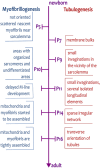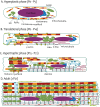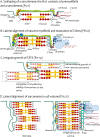From function to structure: how myofibrillogenesis influences the transverse-axial tubular system development and its peculiarities
- PMID: 40352140
- PMCID: PMC12062141
- DOI: 10.3389/fphys.2025.1576133
From function to structure: how myofibrillogenesis influences the transverse-axial tubular system development and its peculiarities
Abstract
The transverse-axial tubular system (TATS) is the extension of sarcolemma growing to the cell interior, providing sufficient calcium signaling to induce calcium release from sarcoplasmic reticulum cisternae and stimulate the contraction of neighboring myofibrils. Interestingly, the development of TATS is delayed and matures during the post-partum period. It starts with small invaginations near the sarcolemma, proceeding to grow an irregular network that is later assembled into the notably transversally oriented tubular network. Accumulating evidence supports the idea that the development of TATS is linked to cell dimensions, calcium signaling, and increasing myofibrillar content orchestrated by electromechanical stimulation. However, the overall mechanism has not yet been described. The topic of this review is the development of TATS with an emphasis on the irregular phase of tubule growth. The traditional models of BIN1-related tubulation are also discussed. We summarized the recently described protein interactions during TATS development, mainly mediated by costameric and sarcomeric proteins, supporting the idea of the coupling sites between TATS and the myofibrils. We hypothesize that the formation and final organization of the tubular system is driven by the simultaneous development of the contractile apparatus under cycling electromechanical stimulus.
Keywords: Z-line; cardiomyocyte; costameres; myofibrillogenesis; postnatal development; sarcomere; t-tubules; transverse–axial tubular system.
Copyright © 2025 Sevcikova Tomaskova and Mackova.
Conflict of interest statement
The authors declare that the research was conducted in the absence of any commercial or financial relationships that could be construed as a potential conflict of interest.
Figures




Similar articles
-
Different effects of cardiomyocyte contractile activity on transverse and axial tubular system luminal content dynamics.J Mol Cell Cardiol. 2024 Dec;197:125-135. doi: 10.1016/j.yjmcc.2024.10.014. Epub 2024 Nov 2. J Mol Cell Cardiol. 2024. PMID: 39491670
-
Mechanisms of spontaneous Ca2+ release-mediated arrhythmia in a novel 3D human atrial myocyte model: I. Transverse-axial tubule variation.J Physiol. 2023 Jul;601(13):2655-2683. doi: 10.1113/JP283363. Epub 2022 Oct 27. J Physiol. 2023. PMID: 36094888 Free PMC article.
-
Role of the transverse-axial tubule system in generating calcium sparks and calcium transients in rat atrial myocytes.J Physiol. 2003 Mar 1;547(Pt 2):441-51. doi: 10.1113/jphysiol.2002.034355. Epub 2003 Jan 31. J Physiol. 2003. PMID: 12562899 Free PMC article.
-
Modelling the cardiac transverse-axial tubular system.Prog Biophys Mol Biol. 2008 Jan-Apr;96(1-3):226-43. doi: 10.1016/j.pbiomolbio.2007.07.021. Epub 2007 Aug 11. Prog Biophys Mol Biol. 2008. PMID: 17868782 Review.
-
The transverse-axial tubular system of cardiomyocytes.Cell Mol Life Sci. 2013 Dec;70(24):4695-710. doi: 10.1007/s00018-013-1410-5. Epub 2013 Jul 12. Cell Mol Life Sci. 2013. PMID: 23846763 Free PMC article. Review.
References
-
- Ampong B. N., Imamura M., Matsumiya T., Yoshida M., Takeda S. (2005). Intracellular localization of dysferlin and its association with the dihydropyridine receptor. Acta Myol. 24, 134–144. - PubMed
Publication types
LinkOut - more resources
Full Text Sources

